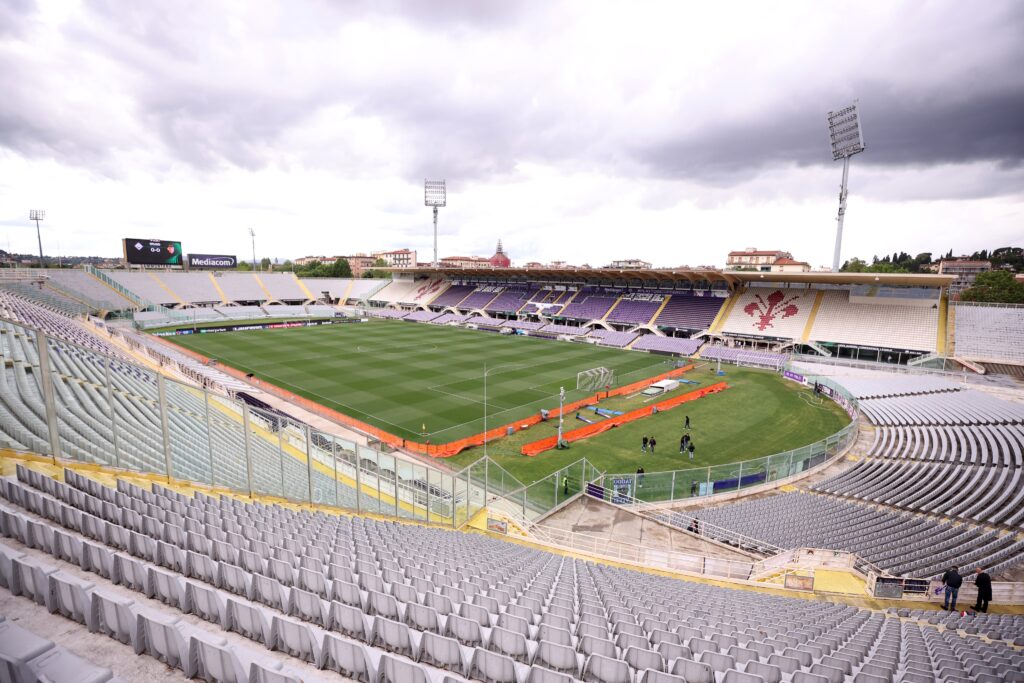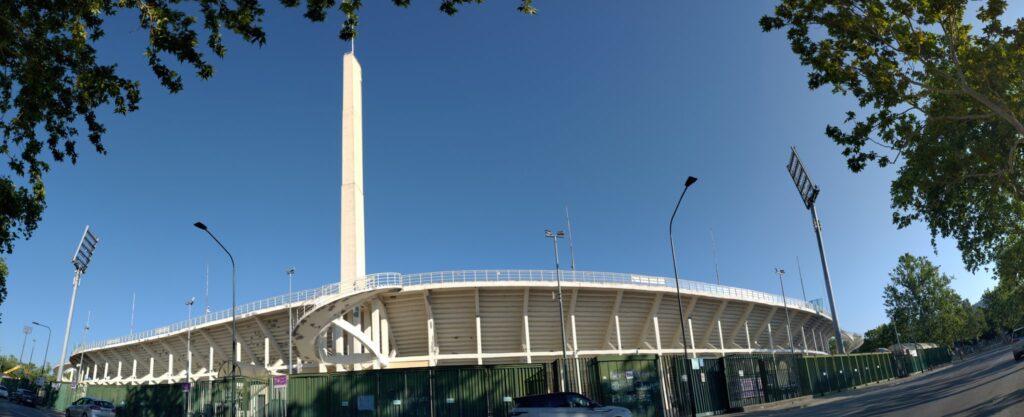
Curious to discover the captivating essence that transforms Stadio Artemio Franchi into a revered symbol of sportsmanship for devoted Fiorentina supporters?
Prepare for a fascinating journey as we venture into the past, peeling back the layers of this architectural wonder.
History and Evolution of Stadio Artemio Franchi
Like a grand old man who has seen the passage of time, Stadio Artemio Franchi stands tall, exuding an aura of history and pride.
It’s hard to imagine that this sporting jewel, the beating heart of Fiorentina, started its life as a modest ground back in 1931.
A Birth by Design
The stadium’s story begins with the vision of architect Pier Luigi Nervi, who designed its innovative structure. Nervi’s use of reinforced concrete, a novelty at the time, was a game-changer.
The Evolution
Stadio Artemio Franchi had its fair share of makeovers. In 1945, it shed its original name, embracing the moniker of Artemio Franchi, the former president of the Italian Football Federation.
The stadium’s capacity expanded in the 1950s, and it received a modern facelift for the 1990 FIFA World Cup. All these changes, big and small, have contributed to the stadium’s current grandeur.
The Anatomy of Stadio Artemio Franchi: A Tour
The Stands: More Than Just Seats
The stands at Stadio Artemio Franchi are steeped in history. Designed by Pier Luigi Nervi, an icon of Italian architecture, their unique structure presents a clever play of light and shadow that makes the stadium an architectural marvel.
But these stunning design elements aren’t the only secrets these stands hold.
Did you know that the stands are named after Fiorentina’s legendary figures? The ‘Curva Fiesole’, for instance, is named after Fiorentina’s ardent supporter group that has always filled the northern stand with incredible passion and fervor.
On the other side of the pitch, ‘Curva Maratona’, the southern stand, pays homage to a monumental marathon event held in the city. The ‘Tribuna Coperta’ and ‘Tribuna Ferrovia’, the covered and railway stands respectively, have their unique stories rooted deep in Fiorentina’s rich history.
Behind The Goal: Up Close and Personal
Can you hear it? The deafening roar of the crowd, the explosive eruption of cheers as the ball sails into the net. There’s no place quite like behind the goal at Stadio Artemio Franchi.
A unique feature of the Franchi stadium, ‘Curva Fiesole’, is situated behind the north goal. This is the heart and soul of the stadium’s most passionate fans, their chants, and cheers forming the backbone of Fiorentina’s home matches.
The Tower of Marathon: A Symbol of Endurance

Standing at a staggering 70 meters high, the “Torre di Maratona” is an iconic feature that pierces the Florentine skyline. It’s not just a landmark—it’s a symbol of endurance and resilience, much like the Fiorentina team itself.
Maratona’s Top: A Panoramic View
Holding the secrets to the most breathtaking view of Florence, the top of the tower is a sight to behold. It’s not open to the public, but legend has it that on clear nights, the glimmering city lights can be seen reflecting in the Arno River.
The Field: Where Legends Are Made
It’s more than just a patch of green turf; it’s a stage where players become legends and legends become immortal. The field at Stadio Artemio Franchi has witnessed countless epic matches, heart-stopping goals, and generations of Fiorentina icons making their mark.
The Locker Rooms: Behind The Scenes
The locker rooms are a sacred, off-limits area steeped in ritual and camaraderie. It’s here that strategizing takes place, pep talks are delivered, and players transform from mere men into footballing gladiators.
From Tragedy to Triumph: How Stadio Artemio Franchi Emerged Stronger After the Heysel Disaster
The Heysel Stadium disaster of 1985, a horrific incident that saw 39 football fans tragically lose their lives during the European Cup final, sent shockwaves throughout the world.
In the aftermath of this tremendous tragedy, Stadio Artemio Franchi stood as a beacon of resilience and hope. The home ground of ACF Fiorentina did not just survive this dark era of football history; it emerged stronger, embodying the spirit of triumph overcoming tragedy.
Stadio Artemio Franchi underwent significant enhancements post Heysel. These changes were driven by an unwavering commitment to ensuring the safety and comfort of its spectators, while simultaneously preserving its iconic architectural charm.
“The disaster at Heysel was a stark wake-up call for football stadiums throughout Europe. We were determined to learn from it, to honor the victims through action,” shared a senior official from Fiorentina during an interview.
One of the key upgrades was the implementation of rigorous safety standards. The stadium’s visitor capacity was reduced to allow more space for each spectator, and stringent protocols were established to manage crowd flow effectively. This ensured that in times of emergency, a safe and swift evacuation could be executed.
Another notable improvement was the revamping of the stadium’s infrastructure. The hallowed turf, the lighting system, the seating arrangements, and even the washroom facilities were all upgraded to provide a superior match-day experience for the Fiorentina faithful. The stadium, in essence, was reborn.
Today, Stadio Artemio Franchi is a constant reminder of how football, in its darkest hour, found a way to push through the gloom and rediscover its joy.
Read Also: From Naples to the World: Exploring the Iconic Stadio Diego Armando Maradona Stadium
Famous Matches and Moments at Stadio Artemio Franchi
Stadio Artemio Franchi a place where victories were savored, losses were mourned, and memories were etched into hearts of the fans. Each corner of the stadium whispers tales of legendary games and unforgettable moments.
The 6-0 Rout against Napoli, 1988: If there’s one match that fans still talk about with wide-eyed wonder, it’s the 1988 clash against Napoli. Fiorentina was in blistering form, ruthlessly dismantling Napoli in a 6-0 demolition job.
The Dramatic 4-3 Victory Over Juventus, 1994: Another match etched in Fiorentina folklore is the pulsating 4-3 win over Juventus in 1994. In a game that had everything — passion, drama, and a last-minute winner — the Fiorentina faithful experienced a full range of emotions.
UEFA Cup Semi-final, 1997: The 1997 UEFA Cup semi-final tie against Barcelona is another landmark moment. Battistini’s goal that sent Fiorentina to the final is a moment no fan can forget. That night, Stadio Artemio Franchi was a cauldron of noise and passion, a testament to the unbreakable bond between the team and its fans.
It’s not just all about the victories, but moments define the character of the club. Like the standing ovation the Fiorentina fans gave to rival player Alessandro Del Piero in 2012, recognizing his greatness despite the colors he wore. These instances may not win matches, but they won hearts and showed the world what Fiorentina is all about.
Every game adds a new chapter to its rich tapestry, making it an enduring symbol of Fiorentina’s sporting journey.
1954 UFO sightings
In October 1954, there were multiple UFO sightings reported in Italy, including in Florence where Stadio Artemio Franchi is located. A reserve game between Fiorentina and nearby rivals Pistoiese was under way at the Stadio ArtemioSome.
Spectators witnessed the event and described the UFOs as cigar shaped object hovering over the city. Others reported seeing a bright light in the sky.
These remarkable sightings ignited a wave of UFO hysteria across Italy, captivating the imaginations of countless individuals who became convinced that Aliens from beyond our world were visiting our planet Earth.
While the existence of UFOs lacks concrete evidence, it’s important to acknowledge the perspectives of skeptics. They argue that the reported sightings could potentially be attributed to misidentifications of natural occurrences or man-made objects.
Their skepticism extends to considering the possibility of hoaxes or even hallucinations playing a role in these accounts. It is through such critical examination and diverse viewpoints that we navigate the intriguing realm of UFO phenomena, continuously seeking to unravel the truth behind these enigmatic encounters.
No matter the authenticity of these sightings, the UFO phenomenon of 1954 has undeniably embedded itself within Italian popular culture, leaving an everlasting impression.
A Day in the Life of a Fiorentina Fan at Stadio Artemio Franchi
Picture this: it’s match day in Florence, the air is charged with anticipation and the streets are awash in a sea of purple.
As a devoted supporter of Fiorentina, you understand the immense significance of today’s match and the pivotal role that Stadio Artemio Franchi assumes
The Journey to the Stadium
Your day starts early. Pulling on your jersey, you feel a wave of pride – you’re not just supporting a team, you’re part of a community, a family. Your journey to the stadium is a shared experience with fellow fans, a camaraderie that echoes through the streets of Florence.
The Arrival
As you approach the stadium, the towering structure of Stadio Artemio Franchi looms into view. It’s a sight that never fails to take your breath away – a testament to the architectural genius of Pier Luigi Nervi. For those in the know, its unique asymmetrical design hides a wealth of history and secrets.
The Pre-Game Rituals
Once inside, the rituals begin. You find your regular spot, the seat worn from years of eager anticipation and heart-stopping finishes. From here, you join thousands of other fans, chanting and singing, creating an atmosphere that is both exhilarating and intimidating.
The Kickoff
And then, the moment arrives. Kickoff. The roar of the crowd, the rush of adrenaline. There’s nothing quite like it – the thrill of the game, the shared experience, the sheer love of the sport.
Stadio Artemio Franchi, with its unique quirks and rich history, is the perfect stage for such an event. It’s more than a game. It’s a way of life.
Practical Tips and Tricks for a Smooth and Enjoyable Experience In Stadio Artemio Franchi
To fully enjoy Stadio Artemio Franchi , there are a few tips and tricks that can significantly enhance your experience.
First Things First: The Tickets
Getting tickets to a Fiorentina game can seem like a daunting task. But fear not, fellow sports enthusiasts! There are several ways to get your hands on those precious paper stubs.
The most reliable method is purchasing online from the official Fiorentina website or from authorized ticket offices around the city.
Secure your tickets early to avoid disappointment on match day.
Navigating the Stadium
Stadio Artemio Franchi is a labyrinth of passageways, corridors, and stairways. Familiarize yourself with the stadium’s layout before the game to navigate your way around with ease. Fortunately, the friendly staff are always willing to guide lost souls to their designated seats.
The Stadium’s Hidden Gems
Stadio Artemio Franchi is more than what meets the eye. Take a moment to admire the iconic ‘Tower of Marathon’, a standalone structure that has become a symbol of the stadium’s unique architectural style.
If time allows, embark on the stadium tour, which offers a behind-the-scenes look at the dressing rooms and press areas. Remember, the magic isn’t just on the pitch – it’s in the rich history and stunning design that envelops it.
Exploring the Neighborhood and Culture Surrounding Stadio Artemio Franchi
Stadio Artemio Franchi isn’t just a symbol of Fiorentina’s glory – it’s a landmark that emanates the vibrant culture of its neighborhood and the city of Florence.
Let’s take a virtual stroll around the block and immerse ourselves in the local culture that surrounds Stadio Artemio Franchi.
The Artistic Aesthetics
Start your day with a visit to the Museo Stibbert, just a stone’s throw away from the stadium.
It boasts an impressive collection of European, Islamic, and Japanese arms and armory. The museum is set within a mesmerizing park, offering an artistic respite amidst the city’s hustle-bustle.
Historical Highlights
History buffs can explore the majestic Fortezza da Basso, a fort turned exhibition center. Its Renaissance architecture is a reminder of Florence’s illustrious past.
Nearby, the Palazzo dei Congressi stands in the former Medici villa, showcasing the city’s age-old affinity for art and culture.
The Gastronomic Journey
Florence is synonymous with culinary delights. Visit Trattoria da Rocco, a local favorite for traditional Tuscan cuisine. Or try Gelateria Badiani, a gelato shop revered by locals and tourists alike for its delectable choices.
As the evening sets in, make your way to the stadium, where the city’s culture converges with its sporting spirit. The electrifying atmosphere, the chanting of the fans, and the beautiful game of football – it’s a symphony of emotions that sums up the essence of Florence.
